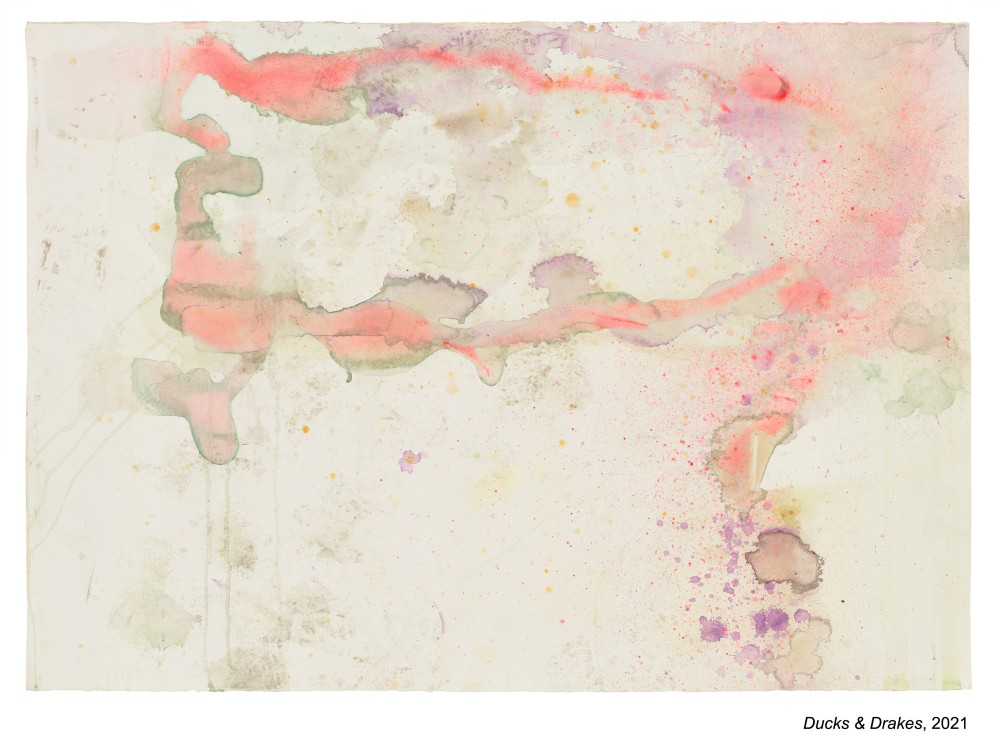
Frank Bowling Works on Paper: 2020 - 2023
Marc Selwyn Fine Art is pleased to announce the gallery’s fourth exhibition with Sir Frank Bowling O.B.E., RA, opening September 14. Frank Bowling, Works on Paper: 2020-2023 features a selection of the artist’s recent paintings on paper that explore Bowling’s enduring experimentation with materiality and abstraction.
A fully illustrated catalogue featuring an essay by curator Sarah Roberts will be published on the occasion of the exhibition. In her essay, Roberts traces how Bowling engages with paper as a three-dimensional, responsive material and how living alongside waterways, from his birthplace, Guyana, to his current home in London, has influenced his abstractions.
The present exhibition is made up of twenty-three works of distinct character that utilize some of the techniques for which Bowling is best known: bold washes of color, traces of daily life in the studio, and edges cut with pinking shears, an homage to childhood memories of his mother’s labor with fabric. Included in the show are works that incorporate sand from the Essequibo River in Guyana, collected by members of his family. Several works also utilize glitter to achieve an ethereal quality, some sparkling like light on water.
Titles reflect the artist’s lifetime living along coastlines from Guyana to New York to London: Dive, 2023, Fishing, 2022, and Fresh Fish Three, 2023. Five works on paper in neon green and luminous blue form a recognizable series that illustrates the artist’s memory of Guyana’s Atlantic coast and the sea wall that runs along it.
Bowling’s finished works reflect the watery movement and dynamic process of their making while existing in a solid state. In her essay, Roberts describes the alchemic quality the artist achieves, emphasizing his mastery of material: “Much as tidal flats or riverbanks act as intermediary realms between land and water, solid and liquid, the works on paper take shape in a zone of transition. Works such as the oceanic Blue Bottom, 2023, convey a sense of both accumulation and dispersal, echoing the way tides wash in and take away debris or remold ripples in the sand again and again.”
Though the sophisticated abstractions allude to nature, Bowling cleverly grounds his work in the studio with the inclusion of the paper’s watermark or a paintbrush hair fixed in paint, or his use of electric manmade pigments. Works such as Back of Heads, 2021, utilize containers found in the studio to create circular impressions in the paper, which the artist collages with found objects. For Noughtnought613, 2021,Bowling fills the portal shape with bright blue canvas and ‘wood wool’, a material typically used for packing material. Bowling’s signature combinations of acrylic and metallic gels with organically flowing pools of paint and found materials result a fluid, complex surface that often changes as the viewer moves around it. Paint bleeds into the paper surface in swells of vibrant hues that prove the artist’s virtuosity as a colorist and a master of material invention.
Bowling began his career at the Royal College of Art after moving from British Guiana to London in 1953. During his time at the RCA, he studied alongside David Hockney, Derek Boshier, Billy Apple, and R.B. Kitaj and became involved in the British Pop Movement of the 1950’s and 1960’s. Bowling moved to New York in 1966 and soon after received a Guggenheim Fellowship. Following a solo exhibition at the Whitney Museum in 1971 (in the same period as shows featuring Melvin Edwards, Jack Whitten, and Alma Thomas), Bowling met influential critic Clement Greenberg, who became a regular visitor to the artist’s studio and a major influence on his practice. With Greenberg’s advice and encouragement, any lingering doubts about his commitment to Modernism were abandoned, and Bowling began to progress further toward pure abstraction, removing all recognizable imagery to focus on process, materials, and color.
Bowling’s work can be found in renowned collections globally including the Metropolitan Museum of Art, New York; Museum of Modern Art, New York; Museum of Fine Arts, Boston; Royal Academy of Arts, London; Tate Gallery, London; Victoria and Albert Museum, London and the Whitney Museum of American Art, New York, among others.
Bowling’s work has been the subject of multiple museum exhibitions over the past fifty years, the most recent ‘Frank Bowling’s Americas’ which traveled from the Museum of Fine Arts, Boston to the San Francisco Museum of Modern Art in 2023. In 2019, he had a retrospective at the Tate Britain. In 2017 he had a major solo show at the Haus Der Kunst, Munich which traveled to the Irish Museum of Modern Art, Dublin and the Sharjah Art Foundation in Sharjah, UAE. Bowling’s work was included in the landmark group exhibition ‘Soul of a Nation: Art in the Age of Black Power’, which began its international tour at the Tate Modern, London in 2017 before travelling to the Brooklyn Museum, New York; the de Young Museum, San Francisco; Crystal Bridges Museum of American Art, Bentonville, Arkansas; The Broad, Los Angeles; and the Museum of Fine Arts, Houston.